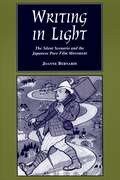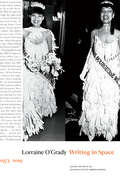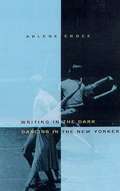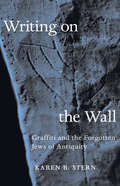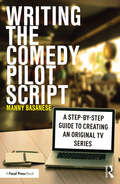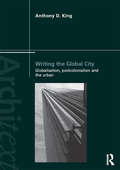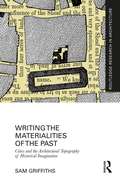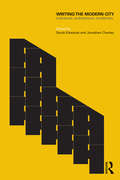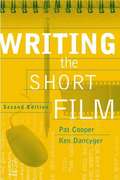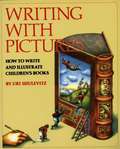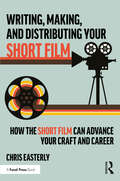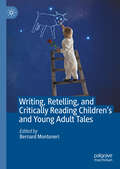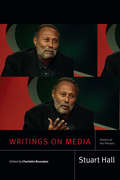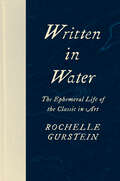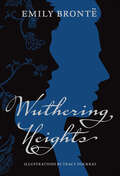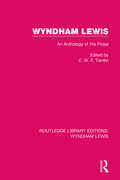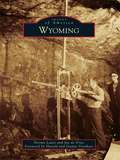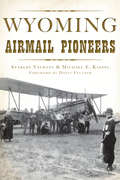- Table View
- List View
Writing in Light: The Silent Scenario and the Japanese Pure Film Movement
by Joanne BernardiWhile most people associate Japanese film with modern directors like Akira Kurosawa, Japan's cinema has a rich tradition going back to the silent era. Japan's "pure film movement" of the 1910s is widely held to mark the birth of film theory as we know it and is a touchstone for historians of early cinema. Yet this work has been difficult to access because so few prints have been preserved. Joanne Bernardi offers the first book-length study of this important era, recovering a body of lost film and establishing its significance in the development of Japanese cinema. Building on a wealth of original-language sources--much of it translated here for the first time--she examines how the movement challenged the industry's dependence on pre-existing stage repertories, preference for lecturers of intertitles, and the use of female impersonators. Bernardi provides in-depth analysis of key scripts--The Glory of Life, A Father's Tears, Amateur Club, and The Lust of the White Serpent--and includes translations in an appendix. These films offer case studies for understanding the craft of screenwriting during the silent era and shed light on such issues as genre, authorship and control, and gender representation. Writing in Light helps fill important gaps in the history of Japanese silent cinema. By identifying points at which "pure film" discourse merges with changing international trends and attitudes toward film, it offers an important resource for film, literary, and cultural historians.
Writing in Pictures
by Joseph McbrideWriting in Pictures is a refreshingly practical and entertaining guide to screenwriting that provides what is lacking in most such books: a clear, step-by-step demonstration of how to write a screenplay.Seasoned screenwriter and writing teacher Joseph McBride breaks down the process into a series of easy, approachable tasks, focusing on literary adaptation as the best way to learn the basics and avoiding the usual formulaic approach. With its wealth of useful tips, along with colorful insights from master screenwriters past and present, this book is invaluable for anyone who wants to learn the craft of screen storytelling.
Writing in Space, 1973–2019
by Lorraine O'GradyWriting in Space, 1973-2019 gathers the writings of conceptual artist Lorraine O'Grady, who for over forty years has investigated the complicated relationship between text and image. A firsthand account of O'Grady's wide-ranging practice, this volume contains statements, scripts, and previously unpublished notes charting the development of her performance work and conceptual photography; her art and music criticism that appeared in the Village Voice and Artforum; critical and theoretical essays on art and culture, including her classic "Olympia's Maid"; and interviews in which O'Grady maps, expands, and complicates the intellectual terrain of her work. She examines issues ranging from black female subjectivity to diaspora and race and representation in contemporary art, exploring both their personal and their institutional implications. O'Grady's writings—introduced in this collection by critic and curator Aruna D'Souza—offer a unique window into her artistic and intellectual evolution while consistently plumbing the political possibilities of art.
Writing in the Dark, Dancing in the New Yorker
by Arlene CroceArlene Croce was The New Yorker's dance critic, a post created for her. Her entertaining, forthright, passionate reviews have revealed the logic and history of ballet, modern dance, and their postmodern variants to a generation of theatergoers.
Writing on the Wall: Graffiti and the Forgotten Jews of Antiquity
by Karen SternFew direct clues exist to the everyday lives and beliefs of ordinary Jews in antiquity. Prevailing perspectives on ancient Jewish life have been shaped largely by the voices of intellectual and social elites, preserved in the writings of Philo and Josephus and the rabbinic texts of the Mishnah and Talmud. Commissioned art, architecture, and formal inscriptions displayed on tombs and synagogues equally reflect the sensibilities of their influential patrons. The perspectives and sentiments of nonelite Jews, by contrast, have mostly disappeared from the historical record. Focusing on these forgotten Jews of antiquity, Writing on the Wall takes an unprecedented look at the vernacular inscriptions and drawings they left behind and sheds new light on the richness of their quotidian lives.Just like their neighbors throughout the eastern and southern Mediterranean, Mesopotamia, Arabia, and Egypt, ancient Jews scribbled and drew graffiti everyplace--in and around markets, hippodromes, theaters, pagan temples, open cliffs, sanctuaries, and even inside burial caves and synagogues. Karen Stern reveals what these markings tell us about the men and women who made them, people whose lives, beliefs, and behaviors eluded commemoration in grand literary and architectural works. Making compelling analogies with modern graffiti practices, she documents the overlooked connections between Jews and their neighbors, showing how popular Jewish practices of prayer, mortuary commemoration, commerce, and civic engagement regularly crossed ethnic and religious boundaries.Illustrated throughout with examples of ancient graffiti, Writing on the Wall provides a tantalizingly intimate glimpse into the cultural worlds of forgotten populations living at the crossroads of Judaism, Christianity, paganism, and earliest Islam.
Writing the Comedy Pilot Script: A Step-by-Step Guide to Creating an Original TV Series
by Manny BasaneseNavigating through the challenging process of writing a comedy pilot, this book will help screenwriters to create an original script for television. Practical and accessible, the book presents a step-by-step guide focusing on the key elements of the process. Incorporating both the history of TV comedy as well as its current evolving state in this age of the dramedy and an ever-increasing variety of broadcast and streaming platforms, the book will serve as a guide for the fledgling sitcom scribe. Author Manny Basanese breaks down the comedy pilot writing process from what may be perceived as an overwhelming, time-consuming mission into a series of much more manageable, smaller steps (from logline to outline to 1st, 2nd and polished draft). Utilizing his experience in Hollywood’s sitcom trenches, the author offers real-world advice on such topics as building the comedy pilot "world," creating memorable comic characters, sound sitcom structure, and the importance of crafting an emotional through line in a comedy pilot. Finally, there is also practical career guidance for marketing this just-completed script and breaking into the industry with advice on various topics such as the value of networking as well as gaining representation in the competitive Hollywood jungle. It is ideal for students of screenwriting and aspiring comedy screenwriters.
Writing the Global City: Globalisation, Postcolonialism and the Urban (Architext)
by Anthony D KingOver the last three decades, our understanding of the city worldwide has been revolutionized by three innovative theoretical concepts – globalisation, postcolonialism and a radically contested notion of modernity. The idea and even the reality of the city has been extended out of the state and nation and re-positioned in the larger global world. In this book Anthony King brings together key essays written over this period, much of it dominated by debates about the world or global city. Challenging assumptions and silences behind these debates, King provides largely ignored historical and cultural dimensions to the understanding of world city formation as well as decline. Interdisciplinary and comparative, the essays address new ways of framing contemporary themes: the imperial and colonial origin of contemporary world and global cities, actually existing postcolonialisms, claims about urban and cultural homogenisation and the role of architecture and built environment in that process. Also addressed are arguments about indigenous and exogenous perspectives, Eurocentricism, ways of framing vernacular architecture, and the global historical sociology of building types. Wide-ranging and accessible, Writing the Global City provides essential historical contexts and theoretical frameworks for understanding contemporary urban and architectural debates. Extensive bibliographies will make it essential for teaching, reference and research.
Writing the History of the British Stage, 1660–1900
by Richard SchochThis is the first book on British theatre historiography. It traces the practice of theatre history from its origins in the Restoration to its emergence as an academic discipline in the early twentieth century. In this compelling revisionist study, Richard Schoch reclaims the deep history of British theatre history, valorizing the usually overlooked scholarship undertaken by antiquarians, booksellers, bibliographers, journalists and theatrical insiders, none of whom considered themselves to be professional historians. Drawing together deep archival research, close readings of historical texts from the seventeenth, eighteenth and nineteenth centuries, and an awareness of contemporary debates about disciplinary practice, Schoch overturns received interpretations of British theatre historiography and shows that the practice - and the diverse practitioners - of theatre history were far more complicated and far more sophisticated than we had realised. His book is a landmark contribution to how theatre historians today can understand their own history.
Writing the Materialities of the Past: Cities and the Architectural Topography of Historical Imagination (Routledge Research in Architecture)
by Sam GriffithsWriting the Materialities of the Past offers a close analysis of how the materiality of the built environment has been repressed in historical thinking since the 1950s. Author Sam Griffiths argues that the social theory of cities in this period was characterised by the dominance of socio-economic and linguistic-cultural models, which served to impede our understanding of time-space relationality towards historical events and their narration. The book engages with studies of historical writing to discuss materiality in the built environment as a form of literary practice to express marginalised dimensions of social experience in a range of historical contexts. It then moves on to reflect on England’s nineteenth-century industrialization from an architectural topographical perspective, challenging theories of space and architecture to examine the complex role of industrial cities in mediating social changes in the practice of everyday life. By demonstrating how the authenticity of historical accounts rests on materially emplaced narratives, Griffiths makes the case for the emancipatory possibilities of historical writing. He calls for a re-evaluation of historical epistemology as a primarily socio-scientific or literary enquiry and instead proposes a specifically architectural time-space figuration of historical events to rethink and refresh the relationship of the urban past to its present and future. Written for postgraduate students, researchers and academics in architectural theory and urban studies, Griffiths draws on the space syntax tradition of research to explore how contingencies of movement and encounter construct the historical imagination.
Writing the Modern City: Literature, Architecture, Modernity
by Sarah Edwards Jonathan CharleyLiterary texts and buildings have always represented space, narrated cultural and political values, and functioned as sites of personal and collective identity. In the twentieth century, new forms of narrative have represented cultural modernity, political idealism and architectural innovation. Writing the Modern City explores the diverse and fascinating relationships between literature, architecture and modernity and considers how they have shaped the world today. This collection of thirteen original essays examines the ways in which literature and architecture have shaped a range of recognisably ‘modern’ identities. It focuses on the cultural connections between prose narratives – the novel, short stories, autobiography, crime and science fiction – and a range of urban environments, from the city apartment and river to the colonial house and the utopian city. It explores how the themes of memory, nation and identity have been represented in both literary and architectural works in the aftermath of early twentieth-century conflict; how the cultural movements of modernism and postmodernism have affected notions of canonicity and genre in the creation of books and buildings; and how and why literary and architectural narratives are influenced by each other’s formal properties and styles. The book breaks new ground in its exclusive focus on modern narrative and urban space. The essays examine texts and spaces that have both unsettled traditional definitions of literature and architecture and reflected and shaped modern identities: sexual, domestic, professional and national. It is essential reading for students and researchers of literature, cultural studies, cultural geography, art history and architectural history.
Writing the Screenplay: TV and Film
by Alan A. ArmerIn this new edition, Emmy - Award winner Alan Armer takes aspiring writers through the essential steps needed to create successful dramatic scripts for TV and Film: visual thinking characters and plotting, story structure and conflict, dialog, and formats.
Writing the Short Film
by Ken Dancyger Patricia CooperThe short film is a unique narrative art form that, while lending itself to experimentation, requires tremendous discipline in following traditional filmic considerations. This book takes the student and novice screenwriter through the storytelling process- from conception, to visualization, to dramatization, to characterization and dialogue- and teaches them how to create a dramatic narrative that is at once short (approximately half an hour in length) and complete. Exercises, new examples of short screenplays, and an examination of various genres round out the discussion.NEW TO THE THIRD EDITION: new screenplays, a chapter on rewriting your script, and a chapter on the future of short films
Writing the Short Film (second edition)
by Ken Dancyger Pat CooperWriters who want to write a fil will find this to be a useful book. The usefulness of this book goes beyond the writing or filmmaking class.
Writing with Feathers
by Rupert Van Wyk Anne RooneyWriting is very important to all of us! But did you know that people in the past did not have the same kind of writing instrument that we use today? Instead of using plastic or metals to create pens, people in the past used feathers to create pens! This story gives a brief history of what people used to write with and how they eventually developed the feather pen! Not only will you have a history of writing, but you will also learn how to create your very own feather pen!
Writing with Pictures: How to Write and Illustrate Children's Books
by Uri ShulevitzA step-by-step guide to creating children's books. The book covers aspects from the preliminary idea to publication, and describes how to tell a story visually, draw characters and develop settings.
Writing, Making, and Distributing Your Short Film: How the Short Film Can Advance Your Craft and Career
by Chris EasterlyThis book is a concise, practical guide to writing and making a successful short film. In an accessible and relatable tone, the book covers the filmmaking process from plot ideation to film distribution, without getting bogged down in the complicated details. Written by an experienced writer and filmmaker, the book shows you how to create content, from script to screen, that can connect with an audience. It does so by considering classic storytelling templates like Aristotle’s Three-Act Structure and Joseph Campbell’s “The Hero’s Journey”, as well as examining a variety of successful short films—analyzing what makes them work, or not, and why. To support learning, it also provides a list of recommended short films to study, with brief background information on each. This is supplemented with the author’s personal experiences of writing and making films, along with exclusive insights from successful Hollywood and independent writers and producers. There are also questions and prompts at the end of each chapter, uniquely designed to guide the reader through the step-by-step process of writing their own short script. Students and professionals alike who want to craft and perfect their short films will find this to be an invaluable resource and a one-stop guide to success.
Writing, Retelling, and Critically Reading Children's and Young Adult Tales
by Bernard MontoneriThis edited collection traces the evolution of writing, retelling, and critically reading children's and young adult tales over decades of cultural, social, and technological changes. Global contributions cover the increasingly diverse narratives found in children's literature, including how contemporary authors challenge traditional gender roles found in fairy tales through modern increasingly prevalent retellings. Chapters also consider the psychological impact of storytelling on children and how narratives can provide children with frameworks for understanding their emotions and experiences.
Writings on Media: History of the Present (Stuart Hall: Selected Writings)
by Stuart HallWritings on Media gathers more than twenty of Stuart Hall's media analyses, from scholarly essays such as “Encoding and Decoding in the Television Discourse” (1973) to other writings addressed to wider publics. Hall explores the practices of news photography, the development of media and cultural studies, the changing role of television, and how the nation imagines itself through popular media. He attends to Britain's imperial history and the politics of race and cultural identity as well as the media's relationship to the political project of the state. Testifying to the range and agility of Hall's critical and pedagogic engagement with contemporary media culture—and also to his collaborative mode of working—this volume reaffirms his stature as an innovative media theorist while demonstrating the continuing relevance of his methods of analysis.
Written in Water: The Ephemeral Life of the Classic in Art
by Rochelle GursteinA deeply personal yet broadly relevant exploration of the ephemeral life of the classic in art, from the eighteenth century to our own day Is there such a thing as a timeless classic? More than a decade ago, Rochelle Gurstein set out to explore and establish a solid foundation for the classic in the history of taste. To her surprise, that history instead revealed repeated episodes of soaring and falling reputations, rediscoveries of long-forgotten artists, and radical shifts in the canon, all of which went so completely against common knowledge that it was hard to believe it was true. Where does the idea of the timeless classic come from? And how has it become so fiercely contested? By recovering disputes about works of art from the eighteenth century to the close of the twentieth, Gurstein takes us into unfamiliar aesthetic and moral terrain, providing a richly imagined historical alternative to accounts offered by both cultural theorists advancing attacks on the politics of taste and those who continue to cling to the ideal of universal values embodied in the classic. As Gurstein brings to life the competing responses of generations of artists, art lovers, and critics to specific works of art, she makes us see the same object vividly and directly through their eyes and feel, in all its enlarging intensity, what they felt.
Wrought Iron and Its Decorative Use
by Arnold Silcock Maxwell AyrtonA superb treasury of decorative wrought iron, this well-illustrated volume presents an informative survey of the ancient craft's practice throughout England. Its history can be traced simply by admiring the crisp black-and-white illustrations of gates, railings, screens, and other elaborately rendered works. 241 black-and-white illustrations.
Wuthering Heights
by Emily Brontë Tracy DockrayWuthering Heights is one of the world's greatest tales of unrequited love, captivating readers with its intense passion and drama since its publication in 1847. In this special collector's edition, the powerful, complex bond between Heathcliff and Catherine that unfolds in the wild, romantic landscape of the Yorkshire moors is beautifully presented in illustrated form for the first time.
Wyndham Lewis: An Anthology of His Prose (Routledge Library Editions: Wyndham Lewis #3)
by E. W. F. TomlinOriginally published in 1969, this project had Wyndham Lewis’ personal approval and is a comprehensive anthology of his prose writings, especially those which are difficult to access. There are extracts from some of Wyndham Lewis’ remarkable books such as Paleface, The Art of Being Ruled and Men Without Art. Lesser known works such as Filibusters in Barbary, The Diabolical Principle and The Dithyrambic Spectator, Blasting and Bombardiering, and Rude Assignment, are freely drawn upon and there is a section devoted to writings on the USA, a country which Lewis knew well.
Wyoming
by Jay De Vries Norma LewisWyoming, Michigan, became a city in 1959, the same year Alaska and Hawaii became states, but its history began more than a century earlier. The first permanent settlers came in 1832, and in 1848, the region split, with the northern portion becoming Wyoming and the southern, Byron Center. Wyoming flourished. The farmers came first with the businesses that supported them. Industry followed. The various gypsum mines were among the earliest arrivals. General Motors built a stamping plant on Thirty-sixth Street that helped pull the township out of the Great Depression in 1936. It was a success, so the company built a diesel plant on Burlingame Avenue. Reynolds Metals, Steelcase, Light Metals, Bell Fibre, and others found Wyoming a good place to relocate. People wanted to live where they worked, and that meant an ever-increasing number of houses were built, followed by additional schools, churches, shops, and restaurants. Rogers Plaza was West Michigan's first enclosed mall. Though often contentious, the local government did its best to live up to an ambitious slogan, "Wyoming: the City of Vision and Progress."
Wyoming Airmail Pioneers (Transportation)
by Foreword By Feltner Starley Talbott KasselThe story of the United States Transcontinental Air Mail Service, the first of its kind in the world, is one of romanticism and danger. Through calm or storm, in light or dark, a contingent of courageous couriers relayed the public mail across three thousand miles in less than a day and a half—faster than ever before. Though the U.S. Air Mail Service began on the East Coast, some of the frontier tales of the route through the Rocky Mountains were lost. The western leg of the airmail service from Chicago to San Francisco included the Mountain Division, headquartered in Cheyenne, Wyoming. The route through Wyoming, considered the most treacherous, provided harrowing tales of the pilots who risked their lives. Authors Starley Talbott and Michael Kassel lionize these folk heroes, aviation legends and icons of western history.
Wyoming County
by Ed Robinson David Bugs" StoverBecause of its rich coal heritage and breathtaking scenery, many regard Wyoming County as the hidden gem of southern West Virginia. The county's vibrant history began with Native Americans, whom many believe left behind the petroglyphs that attract national attention, and continued to its early residents, who farmed and flourished in the logging industry. In 1906, when the Deepwater Railroad (later the Virginian) came to the town of Mullens, Wyoming County's role as a provider of the nation's natural resources was strengthened. By the 1920s, the county was one of West Virginia's foremost coal-producing counties; it maintains that position today. In addition to its integral part in resource exportation, Wyoming County is legendary for its sports scene. Such great players and coaches as Curt Warner, star running back of Penn State and the Seattle Seahawks; Mike D'Antonio, head coach of the Phoenix Suns; and Joe Pendry, assistant coach of the Houston Texans, got their start in Wyoming County. In recent years, this area has been best known for its recreational opportunities. Twin Falls State Park and R. D. Bailey Lake attract thousands of tourists annually, and the Coal Heritage Trail gives residents and visitors alike a chance to see how coal influenced the growth of the region.
